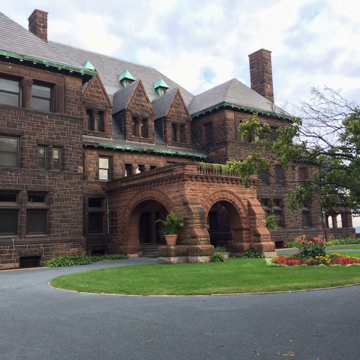When asked the secret of success, James J. Hill responded, “work, hard work, intelligent work, and then more work.” The James J. Hill mansion, a 36,000-square-foot structure in St. Paul, Minnesota, built as a symbol of his success, seems to exemplify the hard work he valued throughout his life.
Hill was born September 16, 1838 in Ontario, Canada. At the age of nine, he lost sight in his right eye due to a bow and arrow injury; at fourteen, his father died and Hill moved to St. Paul three years later, working as a shipping clerk on the Mississippi River. Within seven years he owned a freight and storage business. Twenty years later, he bought the bankrupt St. Paul and Pacific Railroad, quickly expanding it to Canada and across the Rocky Mountains before renaming it the Great Northern Railway. Hill was not only involved in transportation but also milling, banking, and agriculture businesses.
As his national reputation grew, Hill was also amassing an important collection of art. In 1882 he decided it was time to build himself a residence worthy of his status and large enough for his family of twelve. He acquired two lots on Summit Avenue, a fashionable street that had long been home to St. Paul’s wealthiest residents and leading citizens, including the Reverend Edward Duffield Neill, who had served as Abraham Lincoln’s private secretary. Neill’s house, the first residence built on Summit Avenue, sat on one of the lots acquired by Hill, who razed it to make room for a mansion designed by the renowned Boston firm Peabody, Stearns and Furber. The architects and over 400 craftsmen began working on 240 Summit Avenue in 1888. Hill had strong opinions about how his house should be built and he closely monitored the progress of construction. When Peabody, Stearns and Furber failed to communicate their client’s specific orders to the stonecutters working on the house, Hill fired the architects and turned to Irving and Casson, another Boston firm, to complete and furnish the interior.
The 3-story, red sandstone home was built in the fashionable Richardsonian Romanesque style, named after the notable American architect Henry Hobson Richardson and featuring the use of rusticated or large rough-textured stone, and wide, semicircular arches. In the Hill House these are most striking in the porte-cochere. Richardsonian Romanesque is also characterized by an emphasis on horizontal lines and heaviness emphasized here by the deep window reveals. Rooflines become complicated and picturesque through the use of projecting pavilions, including sleeping porches on the northern end and 8 chimney stacks.
The mansion is 187 feet long and 94 feet wide and contains 42 rooms, 22 fireplaces, and 13 bathrooms. The mansion has many common rooms including a library, den, drawing, dining rooms, and a breakfast room. The largest and most decorated room in the house was the 1,500-square-foot art gallery on the first floor, home to Hill’s $1.7 million collection of sculpture and landscape painting. Anchoring this space is a 3-story tall, mechanical action tracker organ with 17 ranks and 1,006 pipes, designed by Boston organ maker George Hutchings. The interior of the house was extremely elaborate with Rococo floral scrolls, columns, Islamic motifs, and decorative woodcarvings throughout the building. The house featured the most advanced technology of the day: in addition to central heating, ventilation, and security systems, the lighting is set up for both gas and electric.
The mansion cost a total of $931,275, the most expensive house in Minnesota when it finished, and the largest in the state as well. Hill died there on May 16, 1916. His wife, Mary, lived there until her death five years later. In 1925, the mansion was given to the Catholic Archdiocese of St. Paul and for the next 50 years, it served as an office building, school, and residence for the church. The structure became a National Historic Landmark in 1961, and in 1978 the Minnesota Historical Society purchased the house with funding from the federal government and the Minnesota Legislature. The James J. Hill House and art gallery are open for tours.
References
Caron, Barbara Ann. “James J. Hill House: Symbol of Status and Security.” Minnesota History(1997): 236-249.
Foster, Gerald. American Houses: A Field Guide to the Architecture of the Home.Boston: Houghton Mifflin Company, 2004.
“The Hill House.” Minnesota Historical Society. Accessed September 20, 2015. http://sites.mnhs.org/historic-sites/james-j-hill-house/hill-house.
Johnson, Craig. James J. Hill House.St. Paul: Minnesota Historical Society Press, 1993.














